Upwards movement resumed as expected for the session.
Two Elliott wave counts are published at the daily chart level. The price point which differentiates them is the all time high.
Summary: Downside risk is at 2,931 for the short term. A pullback or consolidation may unfold here before the upwards trend to new all time highs resumes.
The next target is 3,120. Classic analysis very strongly supports this main wave count.
A new low below 2,825.51 would indicate a deeper pullback should be underway. Look for strong and final support at the lower edge of the wide channel on weekly and daily charts.
The biggest picture, Grand Super Cycle analysis, is here.
Monthly charts were last published here, with video here. There are two further alternate monthly charts here, with video here.
ELLIOTT WAVE COUNTS
The two weekly Elliott wave counts below will be labelled First and Second. They may be about of even probability. When the fifth wave currently unfolding on weekly charts may be complete, then these two wave counts will diverge on the severity of the expected following bear market. To see an illustration of this future divergence monthly charts should be viewed.
FIRST WAVE COUNT
WEEKLY CHART
The basic Elliott wave structure consists of a five wave structure up followed by a three wave structure down (for a bull market). This wave count sees the bull market beginning in March 2009 as an incomplete five wave impulse and now within the last fifth wave, which is labelled cycle wave V. This impulse is best viewed on monthly charts. The weekly chart focusses on the end of it.
Elliott wave is fractal. This fifth wave labelled cycle wave V may end a larger fifth wave labelled Super Cycle wave (V), which may end a larger first wave labelled Grand Super Cycle wave I.
The teal Elliott channel is drawn using Elliott’s first technique about the impulse of Super Cycle wave (V). Draw the first trend line from the end of cycle wave I (off to the left of the chart, the weekly candlestick beginning 30th November 2014) to the end of cycle wave III, then place a parallel copy on the end of cycle wave II. This channel perfectly shows where cycle wave IV ended at support. The strongest portion of cycle wave III, the end of primary wave 3, overshoots the upper edge of the channel. This is a typical look for a third wave and suggests the channel is drawn correctly and the way the impulse is counted is correct.
Within Super Cycle wave (V), cycle wave III is shorter than cycle wave I. A core Elliott wave rule states that a third wave may never be the shortest. For this rule to be met in this instance, cycle wave V may not be longer in length than cycle wave III. This limit is at 3,477.39.
Cycle wave V may subdivide either as an impulse or an ending diagonal. Impulses are much more common. This main wave count expects that cycle wave V may be unfolding as an impulse.
The daily charts below will focus on all of cycle wave V.
In historic analysis, two further monthly charts have been published that do not have a limit to upwards movement and are more bullish than this wave count. Members are encouraged to consider those possibilities (links below summary) alongside the wave counts presented on a daily and weekly basis.
MAIN DAILY CHART
Cycle wave V is seen as an impulse for this wave count.
Within cycle wave V, primary waves 1 and 2 may be complete. Primary wave 3 may have begun.
Primary wave 3 may only subdivide as an impulse. Within primary wave 3, intermediate waves (1) and (2) may be complete.
Intermediate wave (3) may have begun. Intermediate wave (3) may only subdivide as an impulse.
Within intermediate wave (3), minor waves 1 and 2 may be complete. Within minor wave 3, minute waves i through to iii may now be complete.
If the degree of labelling within minor wave 3 is moved down one degree, then it may be only minute wave i within minor wave 3 which is nearing an end. Minute wave ii may not move beyond the start of minute wave i below 2,825.51.
All of primary wave 3, intermediate wave (3), minor wave 3 and minute wave iii may only subdivide as impulses.
Intermediate wave (3) must move far enough above the end of intermediate wave (1) to then allow intermediate wave (4) to unfold and remain above intermediate wave (1) price territory.
HOURLY CHART
Minor wave 3 is again relabelled today. The middle of a third wave may have passed. The structure now looks complete at hourly and daily time frames.
Minute wave iv may now unfold over one to four sessions. It may be most likely a zigzag to exhibit alternation with minute wave ii, but it may also be a combination or triangle. Minute wave iv would most likely be very shallow; the 0.146 and 0.236 Fibonacci ratios may be preferred targets. If it is deep and time consuming enough, then minute wave iv may find support at the lower edge of the Elliott channel.
Redraw the Elliott channel from the ends of minute waves i to iii, then place a parallel copy on the end of minute wave ii. This channel perfectly contains all of minor wave 3 so far, with the exception of an overthrow for the end of the middle of the third wave. This channel looks correct, so it looks likely that the way the impulse is labelled is now correct.
Minute wave iv may not move into minute wave i price territory below 2,931.
It is also possible to move the degree of labelling within minor wave 3 all down one degree. The impulse labelled here on the hourly chart may only be minute wave i of minor wave 3. The invalidation point for that idea would be back at the start of minor wave 3 at 2,825.51.
ALTERNATE DAILY CHART
This alternate wave count has been published before. It will be published again as a reminder that alternates do currently exist
This alternate wave count is still judged to have a low probability because it does not currently have support from classic technical analysis.
The main wave count expects cycle wave V to unfold as the more common impulse. This alternate wave count looks at the less likely possibility that cycle wave V may unfold as an ending diagonal.
All sub-waves within ending diagonals must subdivide as zigzags. The second and fourth waves of diagonals are commonly very deep, correcting to between 0.66 and 0.81 the prior wave.
Within the zigzag of primary wave 2, intermediate wave (B) may not move beyond the start of intermediate wave (A) above 3,027.98.
At this stage, a new low below 2,825.51 would be required for any confidence in this wave count.
SECOND WAVE COUNT
WEEKLY CHART
This weekly chart is almost identical to the first weekly chart, with the sole exception being the degree of labelling.
This weekly chart moves the degree of labelling for the impulse beginning in March 2009 all down one degree. This difference is best viewed on monthly charts.
The impulse is still viewed as nearing an end; a fifth wave is still seen as needing to complete higher. This wave count labels it primary wave 5.
TECHNICAL ANALYSIS
WEEKLY CHART
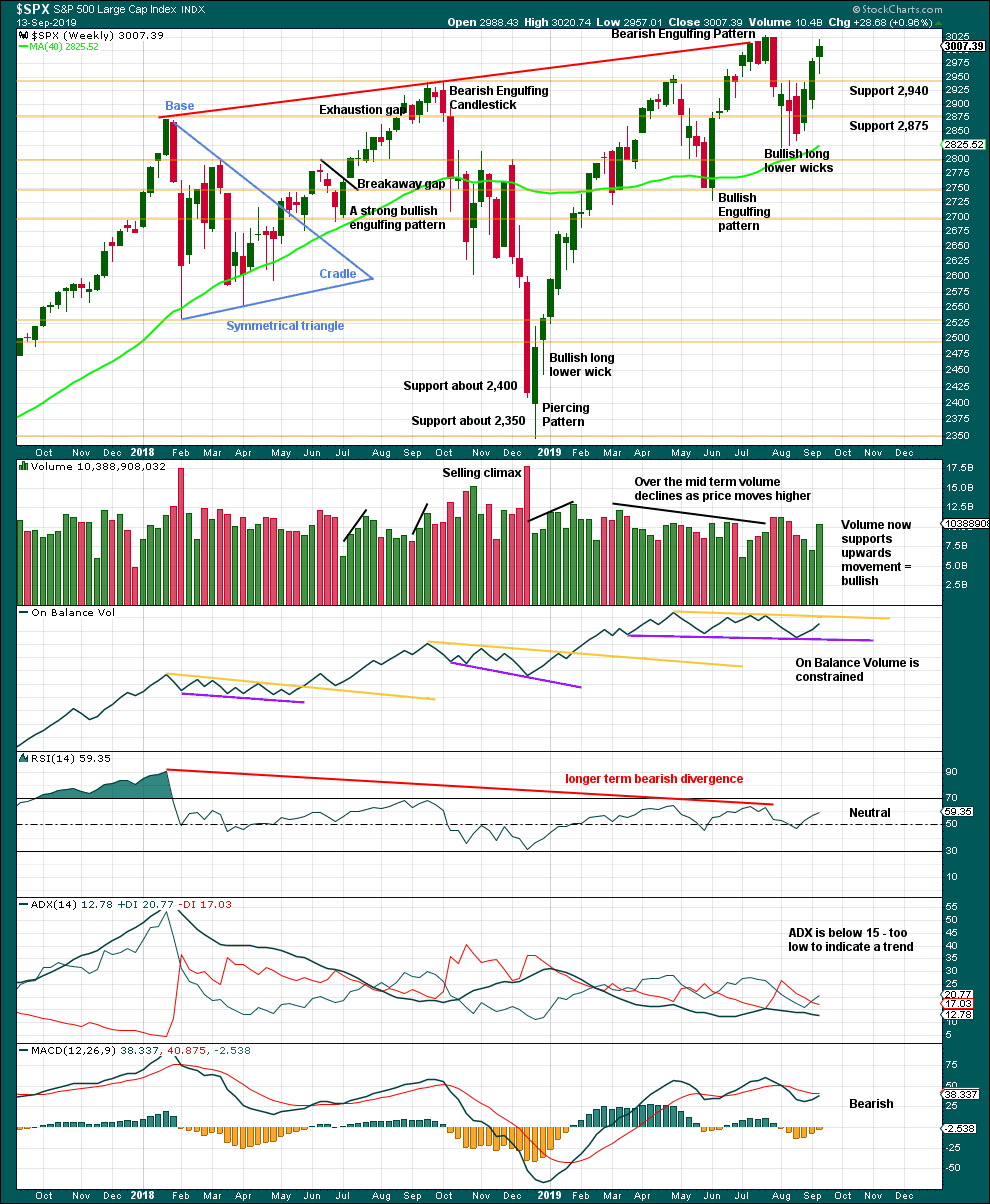
Click chart to enlarge. Chart courtesy of StockCharts.com.
A long lower wick and good support from volume for an upwards week strongly suggests more upwards movement directly ahead.
DAILY CHART

Click chart to enlarge. Chart courtesy of StockCharts.com.
There is now a series of higher highs and higher lows since the 5th of August. Strength in 90% up days and back to back 80% up days off lows indicate the lows may be sustainable.
Support at 3,000 has not yet been breached on a closing basis, so it remains intact.
The target from the triangle is at 3,060, which has still not been met and remains valid.
Today a long upper wick completes a Shooting Star reversal pattern. There is risk here of a trend change. However, downside may be limited as On Balance Volume makes a new all time high today and breaks above a new weak resistance line.
BREADTH – AD LINE
WEEKLY CHART
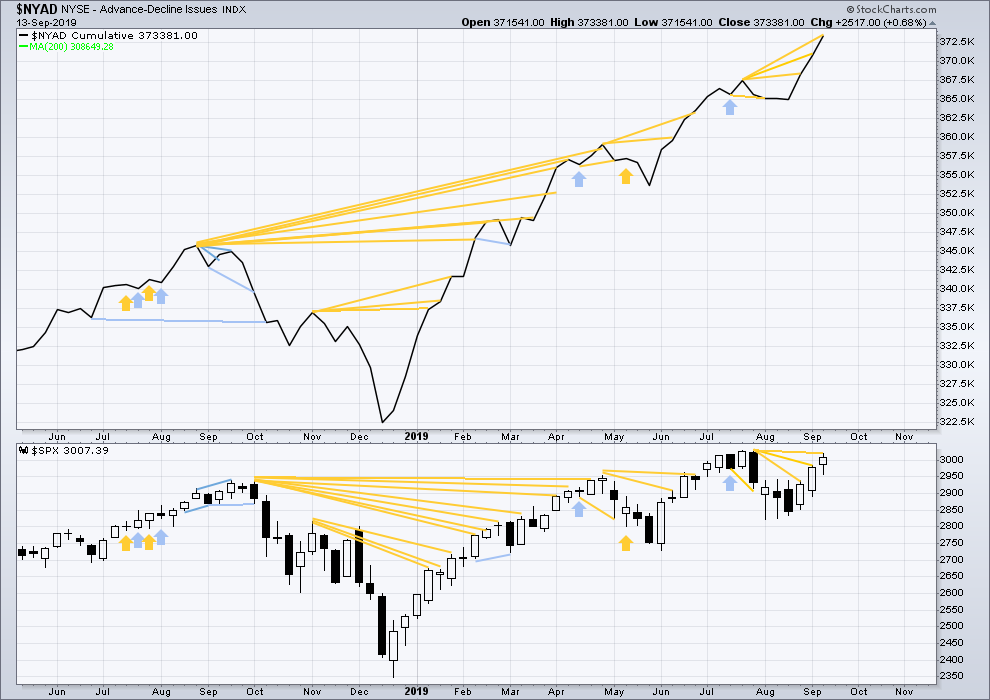
Click chart to enlarge. Chart courtesy of StockCharts.com. So that colour blind members are included, bearish signals
will be noted with blue and bullish signals with yellow.
Bear markets from the Great Depression and onwards have been preceded by an average minimum of 4 months divergence between price and the AD line with only two exceptions in 1946 and 1976. With the AD line making new all time highs again this week, the end of this bull market and the start of a new bear market is very likely a minimum of 4 months away, which is mid January 2020.
In all bear markets in the last 90 years there is some positive correlation (0.6022) between the length of bearish divergence and the depth of the following bear market. No to little divergence is correlated with more shallow bear markets. Longer divergence is correlated with deeper bear markets.
If a bear market does develop here, it comes after no bearish divergence. It would therefore more likely be shallow.
Again, last week both price and the AD line have moved higher.
The AD line makes a new all time high. This is a very bullish signal and very strongly supports the Elliott wave count.
Small caps have made a new swing high above the prior high of the end of July, but mid and large caps have not yet done so. This upwards movement of the last three weeks appears to be led by small caps. Because small caps are usually the first to exhibit deterioration in the later stages of a bull market, some strength in small caps at this stage indicates a healthy bull market with further to run.
DAILY CHART
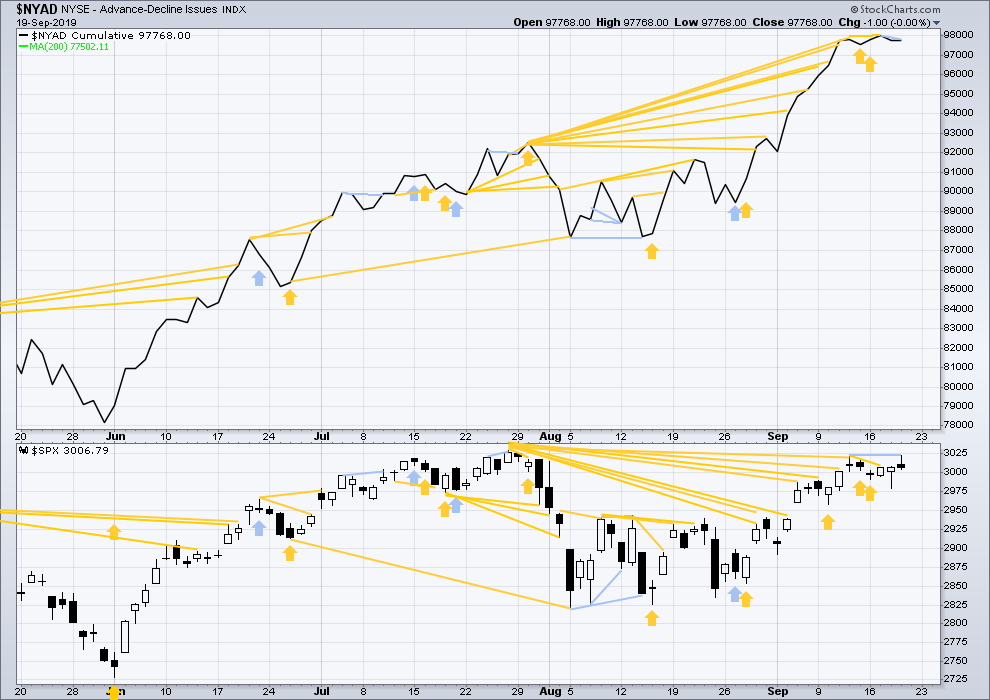
Click chart to enlarge. Chart courtesy of StockCharts.com. So that colour blind members are included, bearish signals
will be noted with blue and bullish signals with yellow.
Breadth should be read as a leading indicator.
Price has made a new short-term high, but the AD line remains below its last short-term high. This divergence is very slight, but it is bearish.
VOLATILITY – INVERTED VIX CHART
WEEKLY CHART
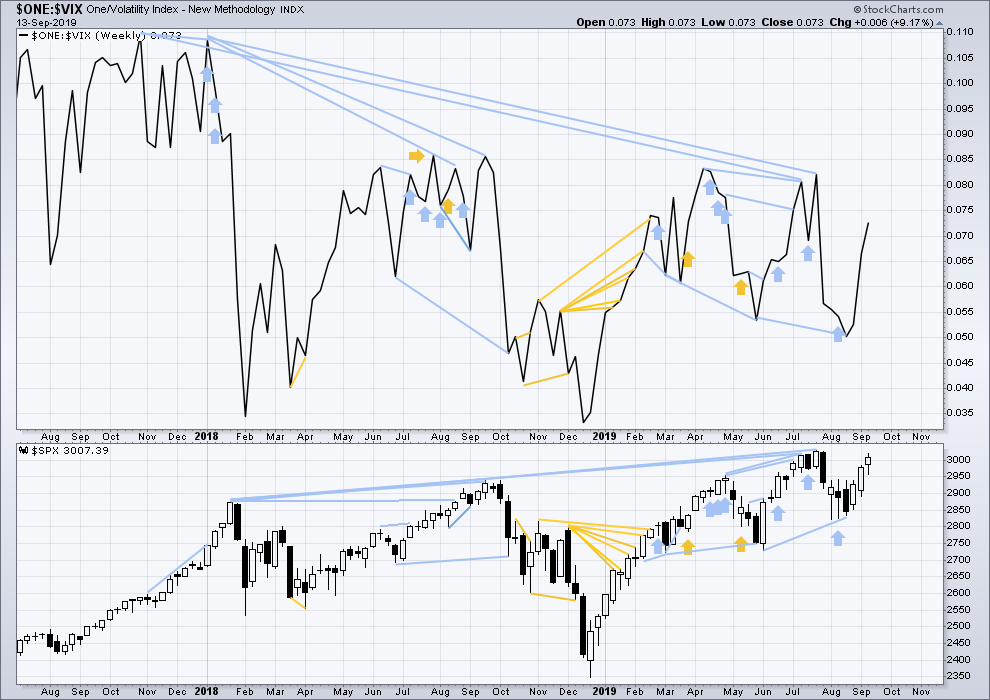
Click chart to enlarge. Chart courtesy of StockCharts.com. So that colour blind members are included, bearish signals
will be noted with blue and bullish signals with yellow.
The all time high for inverted VIX (which is the same as the low for VIX) was on 30th October 2017. There is now nearly one year and ten months of bearish divergence between price and inverted VIX.
The rise in price is not coming with a normal corresponding decline in VIX; VIX remains elevated. This long-term divergence is bearish and may yet develop further as the bull market matures.
This divergence may be an early warning, a part of the process of a top developing that may take years. It may not be useful in timing a trend change.
Again, last week both price and inverted VIX have moved higher. There is no new divergence.
DAILY CHART

Click chart to enlarge. Chart courtesy of StockCharts.com. So that colour blind members are included, bearish signals
will be noted with blue and bullish signals with yellow.
Today price has moved higher, but inverted VIX has moved lower. This divergence is bearish for the short term, and it will be given a little weight in this analysis as it confirms a bearish signal from the AD line today.
DOW THEORY
Dow Theory confirmed a bear market in December 2018. This does not necessarily mean a bear market at Grand Super Cycle degree though; Dow Theory makes no comment on Elliott wave counts. On the 25th of August 2015 Dow Theory also confirmed a bear market. The Elliott wave count sees that as part of cycle wave II. After Dow Theory confirmation of a bear market in August 2015, price went on to make new all time highs and the bull market continued.
DJIA: 23,344.52 – a close on the 19th of December at 23,284.97 confirms a bear market.
DJT: 9,806.79 – price has closed below this point on the 13th of December.
S&P500: 2,532.69 – a close on the 19th of December at 2,506.96 provides support to a bear market conclusion.
Nasdaq: 6,630.67 – a close on the 19th of December at 6,618.86 provides support to a bear market conclusion.
With all the indices having moved higher following a Dow Theory bear market confirmation, Dow Theory would confirm a bull market if the following highs are made:
DJIA: 26,951.81 – a close above this point has been made on the 3rd of July 2019.
DJT: 11,623.58 – to date DJT has failed to confirm an ongoing bull market.
S&P500: 2,940.91 – a close above this point was made on the 29th of April 2019.
Nasdaq: 8,133.30 – a close above this point was made on the 26th of April 2019.
Published @ 06:24 p.m. EST.
—
Careful risk management protects your trading account(s).
Follow my two Golden Rules:
1. Always trade with stops.
2. Risk only 1-5% of equity on any one trade.
—
New updates to this analysis are in bold.

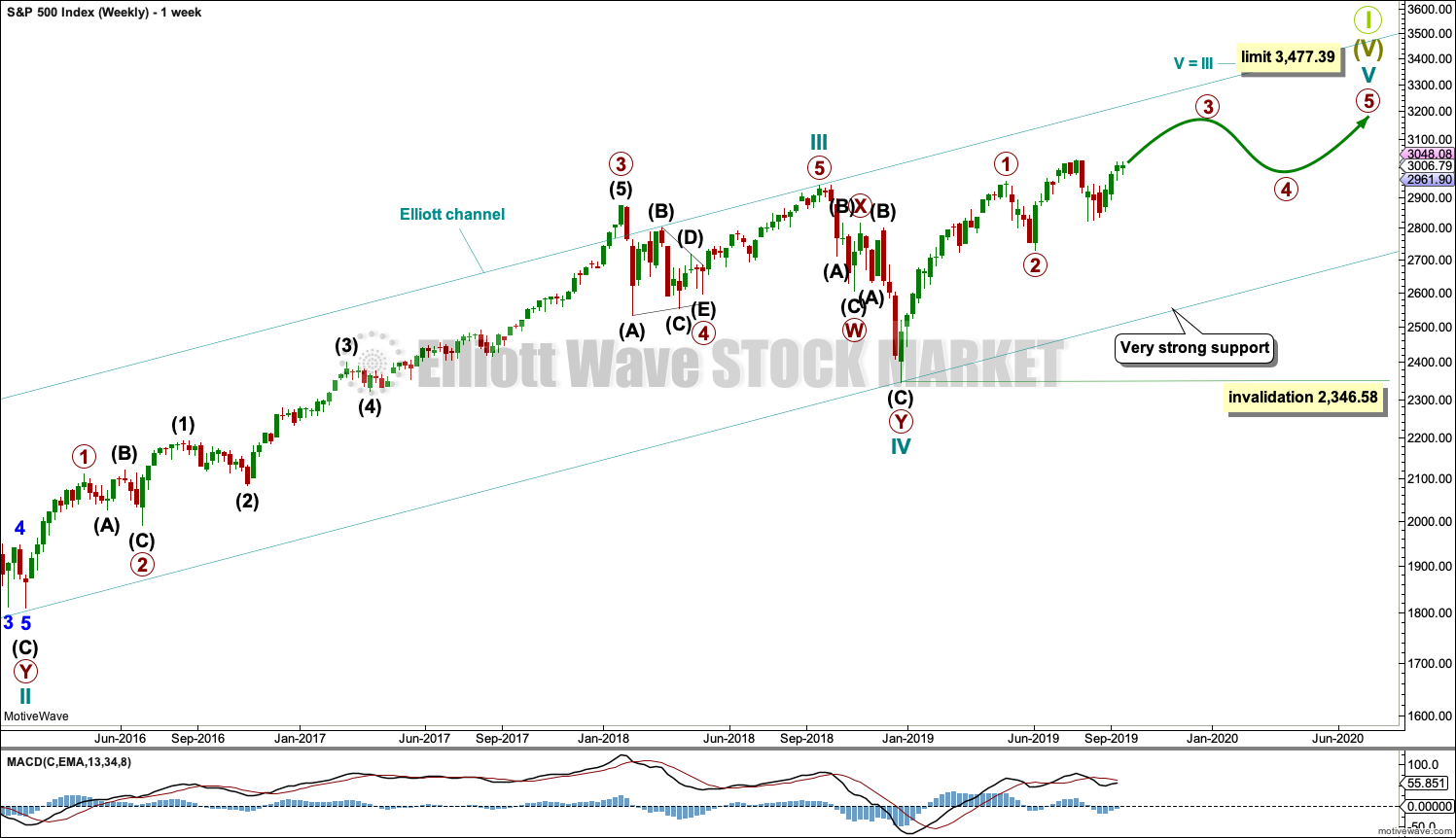


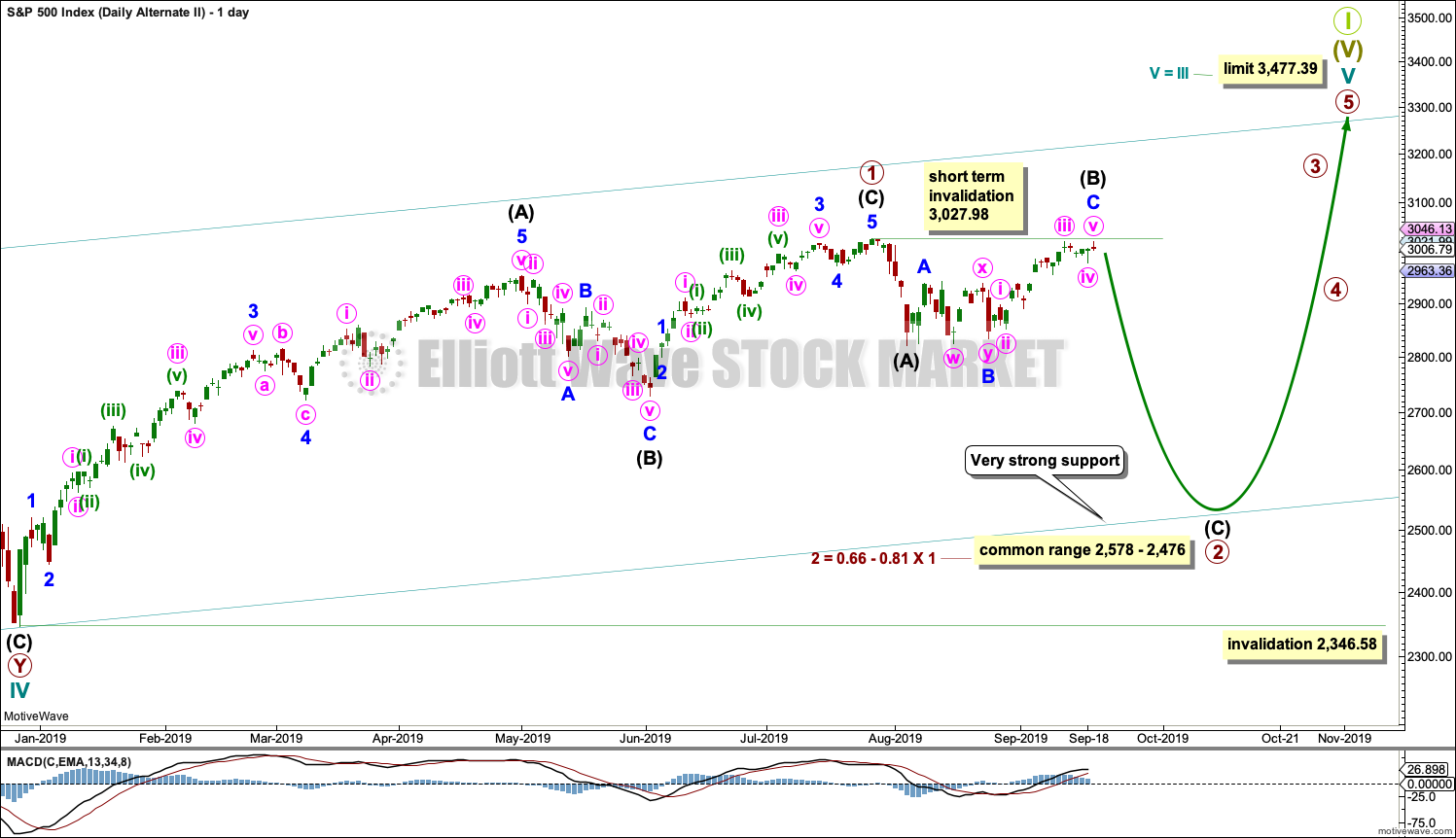
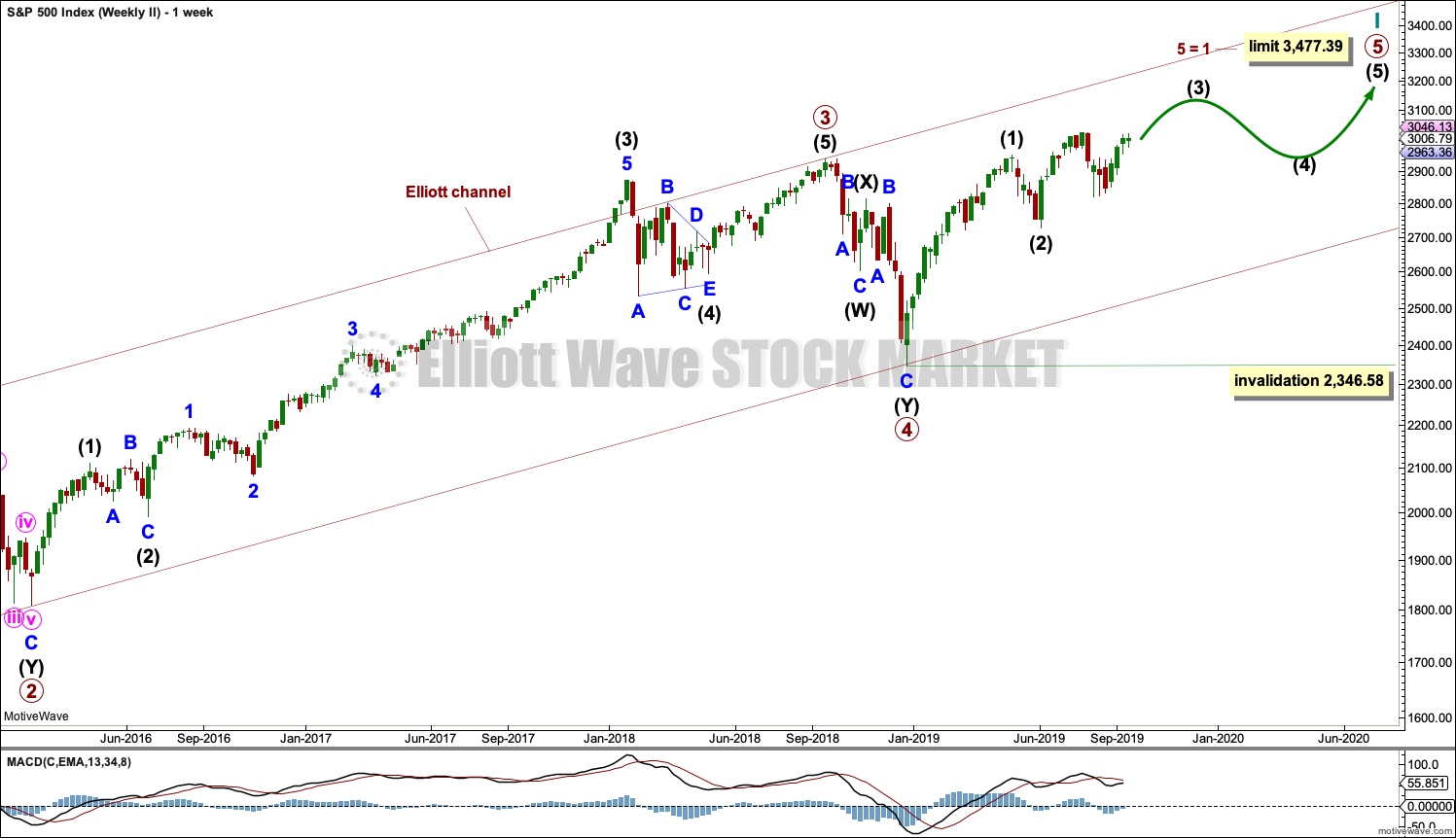
for any stock traders, I’d suggest you consider MSFT to the long side. nice breakout yesterday, bit of pullback today, MSFT has a whole new growing business with cloud services, should power them for quite awhile. stock is roaring overall. I sold Nov puts at 135 for about $340.
I’m also watching TLT closely for a finish to what appears to be a B or X wave up.
See specktrading for real-time setups in different markets.
Hourly chart updated:
If minute iv is a zigzag, then minuette (a) would be an incomplete impulse.
That pullback diagrammed is very consistent with the trader’s almanac that gives the next week or two very bearish “seasonals”, arguably because a lot of fund restructuring will be going on.
The RUT action is looking rather B wave-ish. Like the iv down isn’t complete and a C down is coming. Which would be consistent with Lara’s overnight SPX call that a iv down is due.
At the monthly, RUT is now in month 6 of a squeeze. And it’s just started up a squeeze at the weekly timeframe. The monthly shows the clear “price ceiling” structure in RUT. Break up above that and RUT is probably in a high momentum phase at these higher timeframes.
wow
my sell stop picked me up some cash, took profit and took a big-ish long position
Luck with that. I’m not ready to get long yet. I’m suspecting more iv wave action down next week first. Or I need to see the initiation of something that looks more impulsive up. Or some structure that gets broken to the upside. Right now the hourly in RUT is still in “stair-step down” mode.
my current take…
long iv, but I think that is a safe call
Wam bam!!! C wave down launched.
Or ii of 5 with (slight) new ATH ahead…
Or still in wave 4, now tracing a triangle (c of 4, then d, then e), and 5 is yet to come
your SPY 300 call….. right on
I would just like everyone to know that I will update BTC-USD analysis as requested. But not this week. This week… did not go according to plan.
For now, I am expecting more downwards movement still for BTC-USD.
Following on from Lara’s alternate, dropping done 1 degree, the daily ES may look like something as shown.
It could solve the building issue of (3) not being long enough to comfortably allow (4) to retrace without running into (1).
Nabbed it!